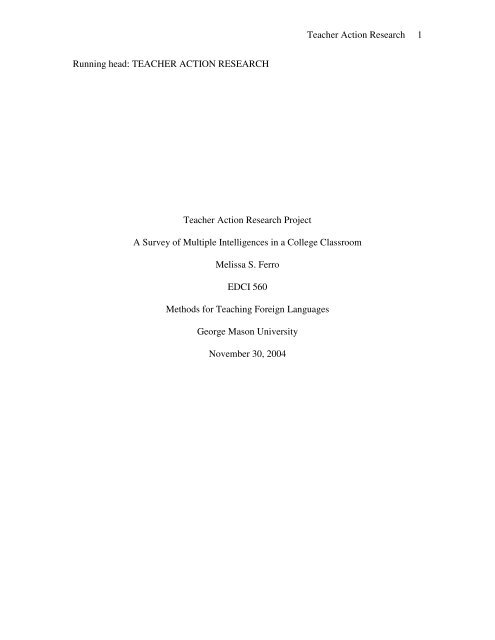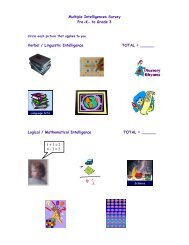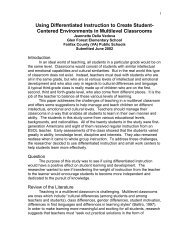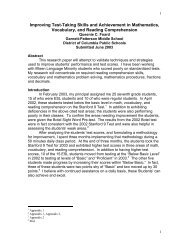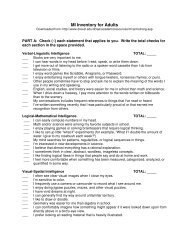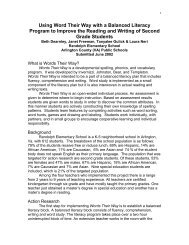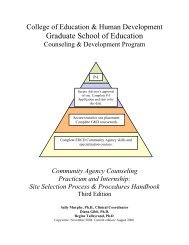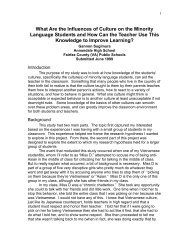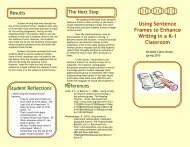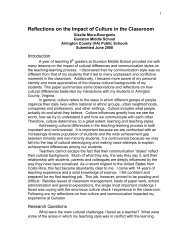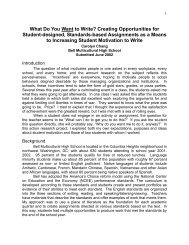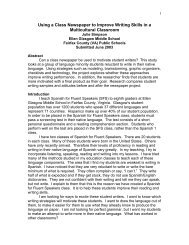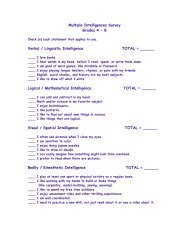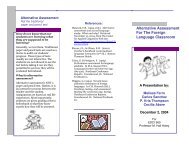Teacher Action Research 1 Running head: TEACHER ... - GSE
Teacher Action Research 1 Running head: TEACHER ... - GSE
Teacher Action Research 1 Running head: TEACHER ... - GSE
- No tags were found...
Create successful ePaper yourself
Turn your PDF publications into a flip-book with our unique Google optimized e-Paper software.
<strong>Teacher</strong> <strong>Action</strong> <strong>Research</strong> 1<br />
<strong>Running</strong> <strong>head</strong>: <strong>TEACHER</strong> ACTION RESEARCH<br />
<strong>Teacher</strong> <strong>Action</strong> <strong>Research</strong> Project<br />
A Survey of Multiple Intelligences in a College Classroom<br />
Melissa S. Ferro<br />
EDCI 560<br />
Methods for Teaching Foreign Languages<br />
George Mason University<br />
November 30, 2004
<strong>Teacher</strong> <strong>Action</strong> <strong>Research</strong> 2<br />
Introduction<br />
I am in my first year of teaching Spanish 101 at George Mason University. This is<br />
a lower division course that is part of the language requirement for students seeking a<br />
baccalaureate of arts degree. This semester, I am teaching one class that has twenty<br />
students, most of whom are in their first year of college. My students have diverse<br />
backgrounds and bring a variety of learning styles to the classroom. At present, there are<br />
no special needs students or students who require special accommodations in the class.<br />
Puzzlement<br />
Earlier this semester, I read the article “Teaching and learning languages through<br />
multiple intelligences” by Mary Ann Christison (1996). Christison believes that language<br />
instructors should design lessons that appeal to all learners. She suggests that teachers<br />
classify the activities that they frequently use in their language classes according to<br />
Howard Gardner’s (1999) multiple intelligence theory (MI theory). In doing so, teachers<br />
can identify what Christison calls “neglected intelligences” (1996, p.11) or those<br />
intelligences that are not represented in classroom activities. Once language teachers<br />
identify the weak areas in their lessons, they can offer more activities for those specific<br />
thinking processes. While reading the article, I asked myself the following 3 questions:<br />
1. Am I using activities in my class that appealed to the nine intelligences<br />
2. How do my students rate each activity based on its usefulness in preparing them<br />
for chapter exams<br />
3. What are the strong and weak intelligences of the students in my classroom
<strong>Teacher</strong> <strong>Action</strong> <strong>Research</strong> 3<br />
Methodology / Data Collection<br />
First, I did an analysis of the activities that I have been using in the course for the<br />
last 2 months. I classified each activity according the thinking processes or intelligences<br />
that would apply. Then, I asked my students to rate the usefulness of each of these<br />
activities based on how well they thought the activity prepared them for an exam<br />
(Appendix 1). Because I wanted my students to rate the activities openly and honestly, I<br />
did not require them to put their names on the Activity Survey. Lastly, I gave each<br />
student a Multiple Intelligence Inventory Survey (Appendix 2) that I obtained from<br />
Walter McKenzie’s surfaquarium web site. To ensure that the students understood that<br />
the Multiple Intelligence Inventory is not an intelligence test, I explained the basics of<br />
Gardner’s (1999) theory.<br />
Data Analysis<br />
Classification of Activities<br />
Activity / Description<br />
“Dos por Dos” a classroom game used to review<br />
chapter material. The class is divided into 2<br />
teams. Two students from each team are asked a<br />
question. The first team to answer correctly earns<br />
a point.<br />
Worksheets: Find and Fix the Mistakes.<br />
Students work individually. <strong>Teacher</strong> reviews<br />
answers with the class<br />
Review Worksheet<br />
In class question and answer sessions on<br />
grammar<br />
Group Quizzes<br />
Individual Quizzes<br />
Individual Cultural Graphs and Diagrams<br />
Group Work: Cultural Review Questions<br />
Signature Grid Competitions: students circulate<br />
the room using the target language to ask their<br />
classmates to initial boxes on a grid if the material<br />
in the box applies to them.<br />
Individual Gustar Posters<br />
Intelligences that Apply<br />
Interpersonal, Kinesthetic, Visual and Verbal<br />
Intrapersonal, Logical, Visual, Verbal<br />
Intrapersonal, Visual<br />
Interpersonal, Visual, Verbal, Logical<br />
Interpersonal, Visual, Verbal<br />
Visual, Intrapersonal<br />
Logical, Visual, Intrapersonal, Naturalist,<br />
Existential<br />
Interpersonal, Logical, Visual, Verbal, Naturalist,<br />
Existential<br />
Interpersonal, Visual, Verbal, Kinesthetic,<br />
Visual, Intrapersonal, Existential
<strong>Teacher</strong> <strong>Action</strong> <strong>Research</strong> 4<br />
Over<strong>head</strong> Transparency Listening Activities<br />
Individual Writing Assignments<br />
Visual, Verbal, Intrapersonal<br />
Visual, Logical, Intrapersonal,<br />
By classifying my classroom activities according to Gardner’s nine intelligences, I am<br />
able to see that I offer substantial activities that appeal to visual, verbal, logical,<br />
interpersonal, and intrapersonal intelligences. While I offer some activities that appeal to<br />
kinesthetic, naturalist and existential intelligences, I do not offer any activities for<br />
musical intelligence.<br />
The Results of the Multiple Intelligence Inventory:<br />
Visual Intelligence<br />
Naturalist Intelligence<br />
Number of Students<br />
6<br />
5<br />
4<br />
3<br />
2<br />
1<br />
0<br />
0-20 30-40 50-60 70-80 90-100<br />
Number of Students<br />
8<br />
7<br />
6<br />
5<br />
4<br />
3<br />
2<br />
1<br />
0<br />
0-20 30-40 50-60 70-80 90-100<br />
Intelligence Profile Score<br />
Intelligence Profile Score<br />
Verbal Intelligence<br />
Intrapersonal Intelligence<br />
7<br />
7<br />
Number of Students<br />
6<br />
5<br />
4<br />
3<br />
2<br />
1<br />
Number of Students<br />
6<br />
5<br />
4<br />
3<br />
2<br />
1<br />
0<br />
0-20 30-40 50-60 70-80 90-100<br />
0<br />
0-20 30-40 50-60 70-80 90-100<br />
Intelligence Profile Score<br />
Intelligence Profile Score<br />
Musical Intelligence<br />
Logical Intelligence<br />
Number of Students<br />
7<br />
6<br />
5<br />
4<br />
3<br />
2<br />
1<br />
0<br />
0-20 30-40 50-60 70-80 90-100<br />
Number of Students<br />
9<br />
8<br />
7<br />
6<br />
5<br />
4<br />
3<br />
2<br />
1<br />
0<br />
0-20 30-40 50-60 70-80 90-100<br />
Intelligence Profile Score<br />
Intelligence Profile Score
<strong>Teacher</strong> <strong>Action</strong> <strong>Research</strong> 5<br />
Existential Intelligence<br />
Interpersonal Intelligence<br />
Number of Students<br />
8<br />
7<br />
6<br />
5<br />
4<br />
3<br />
2<br />
1<br />
Number of Students<br />
6<br />
5<br />
4<br />
3<br />
2<br />
1<br />
0<br />
0-20 30-40 50-60 70-80 90-100<br />
0<br />
0-20 30-40 50-60 70-80 90-100<br />
Intelligence Profile Score<br />
Intelligence Profile Score<br />
Kinesthetic Intelligence<br />
6<br />
Number of Students<br />
5<br />
4<br />
3<br />
2<br />
1<br />
0<br />
0-20 30-40 50-60 70-80 90-100<br />
Intelligence Profile Score<br />
These results are based on 16 responses. The information I extrapolated from the graphs<br />
was surprising. I did not expect to find that so many of my students have strong<br />
intrapersonal thinking processes. Generally, the students appear to be bored and<br />
uninterested during the intrapersonal activities. Also, I did not expect to see such high<br />
scores for existential and musical intelligences. These results reinforce Christison’s<br />
(1996) suggestions for teachers to create activities for any intelligences that are not<br />
currently represented in their lesson plans. For me, this means creating activities that will<br />
appeal to the 13 students who scored greater than a 50 for musical intelligence.<br />
The following chart shows the percentage of students who scored at or above a 70<br />
for any given intelligence:
<strong>Teacher</strong> <strong>Action</strong> <strong>Research</strong> 6<br />
% of Students with Intelligence Profile Score >= 70<br />
80%<br />
70%<br />
60%<br />
50%<br />
40%<br />
30%<br />
20%<br />
10%<br />
0%<br />
Naturalist<br />
Intelligence<br />
Musical<br />
Intelligence<br />
Logical<br />
Intelligence<br />
Existential<br />
Intelligence<br />
Interpersonal<br />
Intelligence<br />
Kinesthetic<br />
Intelligence<br />
Verbal<br />
Intelligence<br />
Intrapersonal<br />
Intelligence<br />
% of Students<br />
Visual<br />
Intelligence<br />
From this data, I learn that there are equally high visual, kinesthetic and existential<br />
learners in my classroom. Once again, I can see the high percentage of students with a<br />
high score for musical intelligence compared to the percentage of students with high<br />
verbal, logical and naturalist intelligences.<br />
The Results of the Activities Survey<br />
The results of the Activities Survey are based on 16 responses. In the next chart, I<br />
show the percentage of students that rate each activity as being very useful or extremely<br />
useful in preparing them for an exam.<br />
% of Students Rating Activity Very or Extremely Useful<br />
% of Students<br />
100%<br />
90%<br />
80%<br />
70%<br />
60%<br />
50%<br />
40%<br />
30%<br />
20%<br />
10%<br />
0%<br />
Dos Por Dos<br />
Game<br />
Find and Fix<br />
Mistakes<br />
Review<br />
Worksheet<br />
In class Q+A -<br />
Grammar<br />
Group<br />
Quizzes<br />
Individual<br />
quizzes<br />
Group Work:<br />
culture<br />
Individual<br />
Work: culture<br />
Signature Grid<br />
Competitions<br />
Individual<br />
Gustar<br />
Over<strong>head</strong><br />
Transparency<br />
Individual<br />
Writing<br />
It is interesting to note that almost 90% of my students found the individual writing<br />
assignments so useful and that almost 80% of my students scored at or above a 70 for
<strong>Teacher</strong> <strong>Action</strong> <strong>Research</strong> 7<br />
intrapersonal intelligence. The high percentage of intrapersonal learners is also evident in<br />
the high percentage of students who thought that other intrapersonal activities (the find<br />
and fix the mistakes worksheet and the review worksheet) were very beneficial for<br />
preparing them for exams. What I did not expect to find is the low percentage (5%) of<br />
students who found the signature grid competitions very or extremely useful. This<br />
activity uses kinesthetic, visual, verbal and interpersonal intelligences. The students are<br />
able to move around the classroom as they interact with each other in the target language.<br />
Since the students always seem to enjoy this activity, I thought the majority of the class<br />
would rate it very or extremely useful. I also anticipated that more than 40% of the<br />
students would find both the group quizzes and the individual quizzes very or extremely<br />
useful in preparing them for the exams. Lastly, I was pleased to learn that 50% of the<br />
students rated 7 of the 12 activities as very / extremely useful.<br />
Conclusion<br />
I developed this puzzlement because I wanted to see if and how I could apply MI<br />
theory to my classroom. While I found MI theory to be very practical, I understand that<br />
there are factors other than a student’s strong or weak intelligences that can influence<br />
his/her opinion of an activity. For example, Krashen’s (1982) affective filter hypothesis<br />
says that any stress a language learner experiences in the classroom can greatly affect<br />
his/her motivation to take risks using the target language. Interpersonal activities can<br />
raise these affective filters since the students may become stressed or nervous when<br />
asked to use only the target language. While my students may prefer the intrapersonal<br />
activities (when their affective filters are low), I hope to show them that they can greatly<br />
benefit from the full array of activities that we use in the classroom. My goal is to
<strong>Teacher</strong> <strong>Action</strong> <strong>Research</strong> 8<br />
continue to improve the learning environment so that my students feel comfortable<br />
enough to take risks using the target language.<br />
To provide the best possible learning environment includes providing a variety of<br />
activities that will apply to all nine intelligences. As a result of this project, I am creating<br />
activities that include musical intelligence in a number of my lesson plans. Also, I try to<br />
make connections between an activity and the intelligences that may apply. For example,<br />
I try to point out natural resources or artifacts when discussing a particular country with<br />
the class or I ask questions that require the students to think about how and why people<br />
from other cultures may have different perspectives than they do. Lastly, I am reconsidering<br />
the use of quizzes since there are other ways to make assessments that might<br />
be more effective.<br />
Unfortunately, this semester is almost over. In January, I will have two new<br />
classes with two new groups of diverse learners. I believe that I can enhance the learning<br />
experience of my students by showing them the benefits of using all nine intelligences in<br />
our classroom activities. Next semester, I plan to give the Multiple Intelligence<br />
Inventory to my students within the first few weeks of class so that I can spend a good<br />
portion of the semester using what I learned in this project.
<strong>Teacher</strong> <strong>Action</strong> <strong>Research</strong> 9<br />
References<br />
Christison, M.A. (1996, Autumn). Teaching and learning languages through multiple<br />
intelligences. TESOL Journal, 10-14.<br />
Gardner, H. (1999). Intelligence reframed: Multiple intelligences for the 21 st century.<br />
New York: Basic Books.<br />
Krashen, S. (1982). Principles and practice in second language acquisition. Oxford,<br />
England: Pergamon Press.<br />
McKenzie, W. (1999). Multiple intelligence survey. Retrieved November 16, 2004 from<br />
http://surfaquarium.com/mi/inventory.htm


